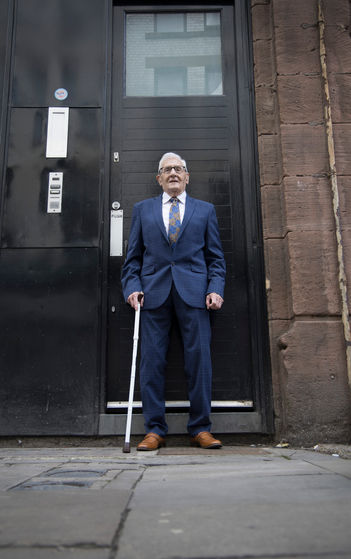
Photography by Demi Holt & Katie O'Neill
George Shepherd is a photographer celebrated for his evocative documentary images of Manchester and Salford, captured between the 1950s and 1970s. His work has been widely exhibited and his digital archive is preserved as part of the British Culture Archive’s permanent online collections.
Born in Eccles, Salford, in 1933 to a working-class family of third-generation mill workers, George discovered his passion for photography early in life. At the age of 12, his father gave him a Box Brownie camera - a gift he still treasures. His first photographs captured the Whit Walks on Lincoln Street, just outside his home in Eccles. By the age of 18, he was photographing the streets, buildings, and people of Salford and Manchester - places deeply familiar to him through visiting with his father, work, or his social life.

Photographer, George Shepherd


I would never leave the house without my camera in case I missed something interesting.


One of George's first photographs - Whit Walk, Eccles, 1947
George Shepherd - An accidental self-portrait
Most of George’s photographs were shot in black and white, and he developed and printed them at home using a makeshift darkroom in his spare bedroom. His images reflect a deeply personal connection to his surroundings - his own visual “memory lane.” Together, they form an important historical record of post-war working-class life in the North West of England.


Girl with Pigeons - Piccadilly, Manchester, 1966 (Photo: George Shepherd)

Factory Workers - Salford, 1966 (Photo: George Shepherd)

Catching up with the News - George's wife, Eccles, 1957 (Photo: George Shepherd)

Silcocks Fair - Eccles, 1966 (Photo: George Shepherd)

Backyard - Salford, 1966 (Photo: George Shepherd)

Boys Playing Cricket - Salford, 1966 (Photo: George Shepherd)

Girls Night Out - Salford, 1958 (Photo: George Shepherd)
Now in his nineties, George’s work continues to gain recognition. In 2021, his solo exhibition A Trip Down Memory Lane was held at Salford Museum. In 2019, he showcased a remarkable collection at Eccles Community Art Gallery, featuring eighty prints salvaged from over a thousand forgotten negatives. These images document the people and streets of Eccles from the 1960s to the 1980s, capturing candid moments and everyday life during a time of significant social change. The exhibition attracted around 2000 visitors over a three week period.
George Shepherd’s powerful monochrome compositions, spontaneous interactions, and keen eye for detail capture the essence of working-class life and the evolving urban landscape. His work stands as a poignant visual chronicle of a bygone era, echoing the spirit and social realism found in L.S. Lowry’s iconic paintings of the same period.
THE SHOOT: Northern Quarter - Tib Street & Back Turner Street
An area where as a youngster George would visit with his father & then return to photograph in the 1960s & 1970s

Related links:
Student reflection: Demi Holt

Photographing George was a real pleasure. No matter how long you've been practicing photography, there’s always a hint of nerves before a shoot. But once you're immersed in the process, those nerves quickly fade.
We met George on Tib Street in Manchester’s Northern Quarter - a place he remembered fondly from childhood visits with his dad. The area’s timeless character made it the perfect backdrop for our session. George even brought along his old film camera, which he held proudly in many of the shots.
Working with him was a genuinely enjoyable experience. Normally, when photographing people, I sometimes feel guilty asking them to hold poses repeatedly. But with George, that wasn’t the case. As a photographer himself, he understood the need for precision and patience. He also shared some wonderful stories about his journey with photography, which helped me feel more at ease.
I was using a camera I wasn’t entirely familiar with, so it took a bit of time to get used to its layout. The lighting that day was soft and overcast, which worked in our favour - just a few ISO adjustments were needed in the darker areas. Although a few of the images turned out slightly blurry, I’m genuinely proud of the final results. The experience reminded me why I love photography: the connection, the creativity, and the lasting reward of capturing something real.





















